All 18 entries tagged Travel Writing
View all 115 entries tagged Travel Writing on Warwick Blogs | View entries tagged Travel Writing at Technorati | View all 66 images tagged Travel Writing
May 26, 2005
Meeting a famous bike
Follow-up to Ted Simon and the art of deterritorialization from Transversality - Robert O'Toole
My GS met up with an old friend at CW's at the weekend. Last February, after I got hit on the head by a rock on a Catalan motorway, it spent several months in the garage at CW's sitting next to a more distinguished GS: that ridden by Ted Simon on his latest round the world ride, soon to be documented in the much awaited book "Dreaming of Jupiter".
Ted's bike is a little more battered (well used) despite being younger than mine. It has of course ridden across Europe, Africa, South, Central and North America, Australia and Asia. So you can excuse a few dents. I expect that it does still run well.
After checking with Dave (and on the basis that I'm a member of the Order of Jupiter), we took a few photos. Here's me on the bike:
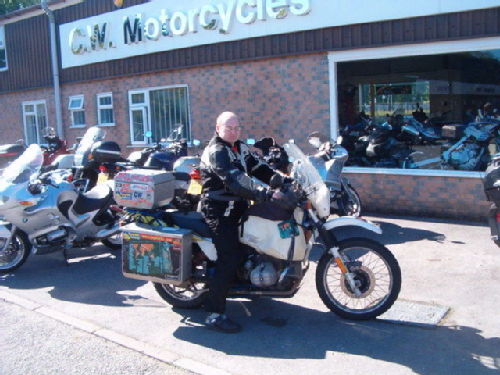
And Martin:
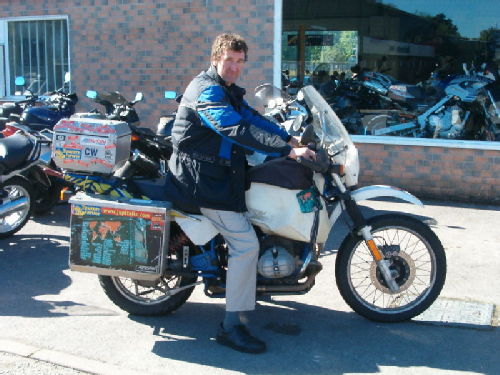
Notice the photo on the side of the pannier, which is of the world map on the side of Ted's original round the world bike from 1972, which is now in Coventry's Transport Museum:
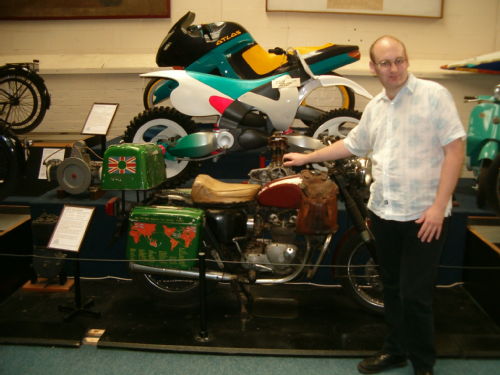
And finally, a photo of our three bkes:
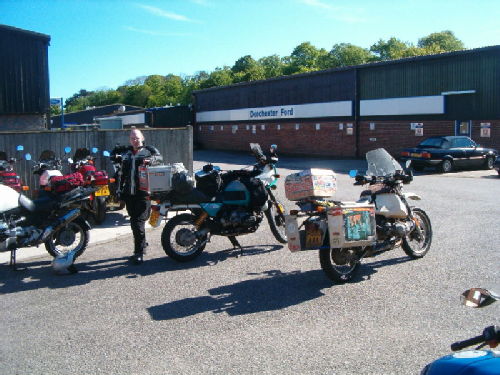
May 23, 2005
CW Motorcycles off road ride, Shaftesbury to Stonehenge
Follow-up to The wisdom of Obi Wan Kenobi from Transversality - Robert O'Toole
Just to prove that the GS is a great off-road bike rather than a two wheeled Range Rover, we went out with a group of 14 of them in difficult conditions across Dorset to Stonehenge.
Martin (BMW R1100GS) and I (BMW R100GS-PD) had a great weekend in Dorset. On Saturday we had our bikes serviced at the always excellent CW Motorcycles in Dorchester, and then stayed in Charminster's Three Compasses Inn for the night (really good beer). On Sunday morning, we met up with the CW Riders Club and went for a swift road blast to Shaftesbury, where a group on 12 other bikes met up. These included almost all of the bikes from the 25 years of the GS range, including an early 80's GS made into a lightweight trail bike…
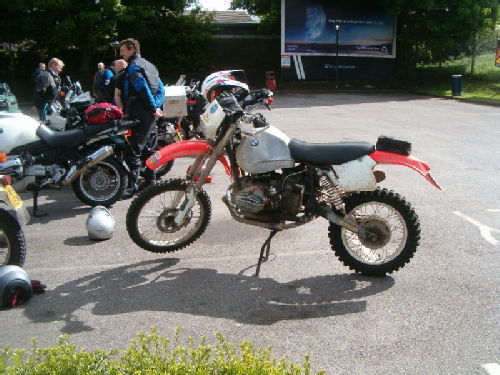
…my '93 GS Paris-Dakar, Wally's GS sidecar outfit next to Martin's R1100GS…
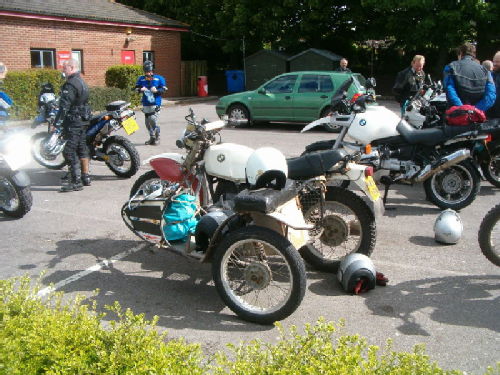
…several F650's, R1150GS's, Martin's R1100GS, and even a new R1200GS.
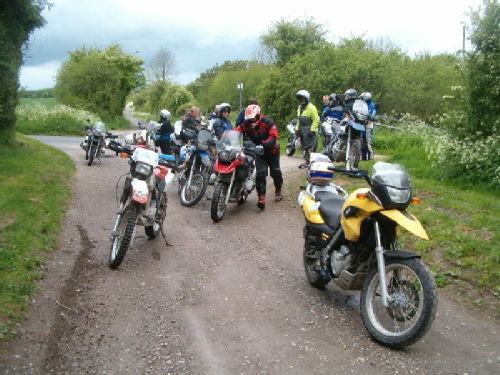
The route was excellent, starting with a long stretch along the top of a ridge – an old drover's route i think. An 1150GS was an early casualty, going over just in front of me as it dug awkwardly into a section of chalk gravel used to repair a worn track. Wally followed us with the mechanic Richard on the side car to help with any problems and more importantly to take photos of the fallen bikes.
We then came to a long section with more pools of water than dry road. This was great fun, splashing down into them, causing a bow wave to splash out, and then powering up the other side. Unfortunately, in one very large pool, I got cross-rutted just as I came out, and ended up going sideways and landing with a splash. As you can see from this photo, I was heavilly loaded with camping gear, which didn't help its stability…

After a short section of road, we turned back onto another byway, leading up a steep hill. By this time it had started to rain, and the chalk track got quite slippery. This was made worse by the deep ruts cut into the hillside, some of which were narrower than my rear tyre, causing it to spin. I paddled my way to the top, with both feet down, pausing twice to rest. Once up to the top, we were treated to better roads and a great view. Martin powered along, much faster than me, seeming thoroughly at home sitting rather than standing on his big white GS.
After some smoother tracks, we reached another road, at which point Wally advised the bikes without full off-road knobbly tyres to take a road route for the last couple of miles, as it had started to rain heavily. Once we reached our destination, it really started to pour.
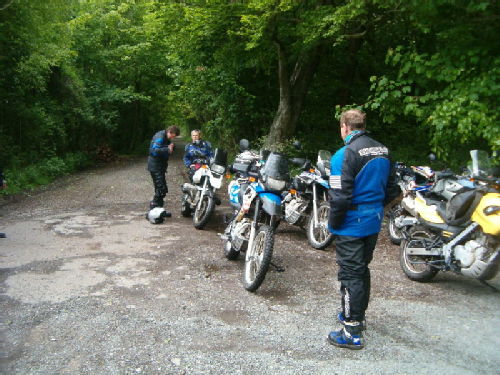
Thanks to all the riders at CW's for making it such a great trip. I'm looking forwards to some more when the weather improves a bit.
The wisdom of Obi Wan Kenobi
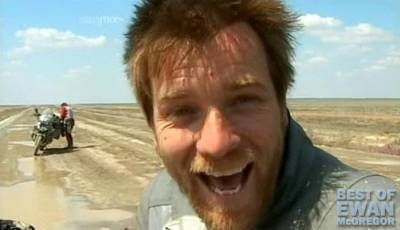
"So, young Jedi, you wish to conquer the universe and defeat the forces of darkness. You will need a vehicle, a special vehicle, one for which there are no bounds, one that will allow you to travel to any part of the empire, no matter how uncivilised and wild. One capable of carrying a wookie as pillion and R2D2 in the top box. Such a vehicle exists. But it is only for the bravest of Jedi. You must choose the BMW Gelandestrasse, and may the transverse twin force be with you."
And so I rode with Martin from Engineering (R1100GS) on my R100GS-PD to Dorset, and accompanied by the CW Motorcycles off-roaders, waged war against mud, rocks, vast pools of water, and those nasty rutted chalk tracks wrecked by the drivers of Range Rovers (Darth Vader's choice of car).
May 20, 2005
Highest mileage GS?
Writing about web page http://www.largiader.com/gs/
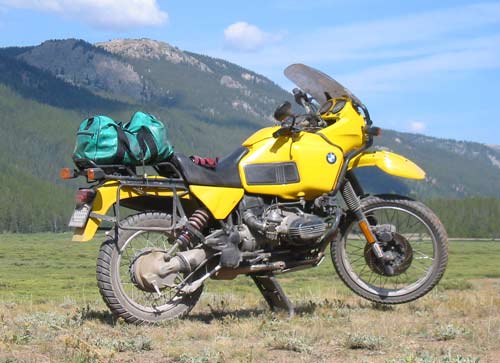
This is The Yellow Peril, also known as The Swamp Thing and Helga. It is a 1993 BMW R100GS PD (Paris-Dakar). It has done over 127,000 miles. Is this the highest mileage GS in existence? In comparison, my GS PD has only done 74,000, so is easily capable of a ride down to Cape Town, or the Long Way Round.
December 18, 2004
Motorcycle lesson number 2: handling power
Follow-up to Watching the road ahead – motorcycle lesson number 1 from Transversality - Robert O'Toole
Do girls like motorcyclists? I think that I have in the past answered this with an emphatic NO. But actually I'm not that certain. I suspect that if one strolls along towards them in leather trousers, smart new Gericke Taureg jacket, carrying a shiny red BMW helmet, and most importantly smiling sweetly, it really does something for them. OK, I admit, I have tried this and can say that it works. But, as my experiments prove, it is the smile that makes all of the difference. Not just any smile, but rather an entirely unexpected smile. Just like that on the face of Shrek when he first sees Princess Fiona. One second you are a monster, and then through a controlled and carefully considered modulation, you are a prince (or at least human).
Bikes teach you that. Not the smile, one hopes that comes naturally, but the control, the timing, and the subtlety. Riding a motorcycle is absolutely nothing like driving a car, as many car drivers find to their embarassment when they first jump onto a bike and snatch at the controls. Any ham-fisted idiot can get into a car, grind through the gears, slam on the brakes, and jerk it through corners without crashing. Ride a bike like that and you would come off right away. Ride a modern sports bike like that, with the power to weight ratio of a rocket and brakes good enough to stop a 747, and you would very quickly be dead.
Smoothe and precise throttle control. Exact and planned gear changes. Balanced application of rear and front brakes. Careful consideration of road surfaces and conditions. Even a consideration of the wind direction. When sitting on a machine with as much power as a modern motorcycle, all of this is necessary. The thing makes a big noise, threatens to kill its rider instantly, stands out from the crowd like a raging bull in the streets of Pamplona, and in return, its rider controls it with a real gentleness and care. Does that sound attractive? A bit like the smile?
Are modern cars changing the behaviour of their drivers? Are they becoming more impetuous, less self-controlled, less gentle? Does their forgiving and safe nature threaten to breed a race of people without care? If so, motorcycles are clearly the antidote.
December 09, 2004
Watching the road ahead – motorcycle lesson number 1
Zen and the Art of Motorycle Maintanance is undoubtedly the worst book ever written. As an account of Eastern Philosophy it is hopeless. As an account of motorcycle maintanance it's downright dangerous. As an attempt at abstracting from motorcycling metaphors and lessons for life, it is infuriating.
The problem is this: motorcycling really does suggest some superb metaphors for life. No, not metaphors, lessons. There are things that one learns as a motorcyclist that apply quite effectively elsewhere. So to make up for Prisig's errors, and to celebrate the more productive writings of the likes of Ted Simon and Desperate Dan Walsh (see this months BiKE magazine), I plan to start collecting and publishing such wisdom right here.
1) Don't look down!
A simple lesson that every motorcyclist learns: look in the direction that you want to go, into the distance, at the place that you'll be by the time you get to think about it, not where you are now. Don't get distracted by what's already under your feet, it's already too late to think about that. And don't ever get fixated on obstacles, hazards or attractive ladies that you are about to pass safely anyway (and besides, girls don't like bikers).
This is especially true of corners. To go around a corner safely and smoothely, one must look at the vanishing point, planning to adjust speed and direction to adapt to it as the information comes in. If you react too late, at the point of already being in the corner, its already too late. The result of getting this wrong is simple, you wobble through the corner, lose grip, brake too late, ignore hazards, and sometimes fall off.
This is all very good, but of course while you are concentrating on the distance, on the vanishing point, stuff is still happening that you have to control. New information is arriving all the time: the road debris that you couldn't see, the diesel spill, the fluctuations in the engine, gearbox, drive and traction. And this is the really important part of the lesson: make your reactions to those things habitual. To be a safe motorcylist, not only must you learn to look into the distance and be strategic, but you must also be able to adapt to the road under your wheels and the control of the bike without even thinking. Your skills need to be so perfect and natural, like breathing.
A balance between habit and strategy, between the predictable management and control processes (tactics) and adaptive intelligent strategy.
Interestingly, since getting bashed over the head on a Spanish motorway, I seem to have lost a little of this in both motorcycling and life. I've fallen off my bike, at slow speeds, several times. This is partly because I am getting distracted and looking down too often, and partly because through a lack of practice I am losing the habits. Moving house did not help. Stopping my regular 130 mile commute contributes. Having to adjust to different eyesight, that works but is different, adds more difficulties. Changing to a more complex and much less predictable job has the same effect.
But over the last week I've started to realise what the problem is, and am concentrating on developing new habits, both on the bike, at home and at work. And things are changing, i'm becoming less distracted, more able to get things done safely, and more able to focus on the road ahead.
You see, biking is good for you!
November 06, 2004
Deleuze and Guattari on the (relative) superiority of English Imperialism
Follow-up to Migration and geophilosophy from Transversality - Robert O'Toole
We do not lack communication. On the contrary, we have too much of it. We lack creation. We lack resistance to the present. (What Is Philosophy? p.108)
In consumer capitalism, Deleuze and Guattari claim, the milieu of the Greeks, the relative deterritorialization of concepts, is impossible. Philosophy is impossible. The firgures of communication, of an ecstacy of communication as Baudrillard described, repeat a single concept, consumer acquisition. No two incommensurable concepts are brought together in a state of relative deterritorialization. There is no resistance. Everything is immediately deterritorialized absolutely (the acquisition claims to make all the difference), and just as quickly reterritorialized (the acquisition makes no difference, follows the same familar order).
There is a diifferent English capitalism, they claim. In the chapter on Geophilosophy, they describe the real drive behind the English imperialism, as something by which neither the Germans nor the French were motivated. Not just a desire to be Greek (as in Heidegger) but more importantly:
…the English are precisely those nomads who treat the plane of immanance as a movable and moving ground, a field of radical experience, an archipelegian world where they are happy to pitch their tents from island to island and over the sea. The English nomadize over the old Greek earth, broken up, fractalized, and extended to the universe…a concept is acquired by pitching one's tent, by inhabiting it, by contracting a habit. (p.105)
English philosophy then is a curious form of travel writing, of travelling along with the great heroes of the Empire (what a misnomer): T.E. Lawrence and Alexander the Great.
And the point at which English Imperialism becomes violent, imposing, extending a State, is at that point at which its subjugated people's pack up their own tents and seek to move on, move away from the romantic ideal: Lawrence being appalled by the Arab desire for Rolls-Royce rather than camel, for their own Capital as much as the oasis:
Europeanization does not constitute a becoming but merely the history of capitalism, which prevents the becoming of subjected peoples. (p. 108)
It just isn't cricket anymore.
November 03, 2004
R1200GS vs R100GS Paris–Dakar
On Sunday I went for a ride out with another local GS rider, Steve from Harbury, who I met through the CW Motorcycles Rider's Club. Steve has had five different GS's, including an R1150GS Adventure, the same as that used by Ewan McGregor and Charlie Boorman for their recent Long Way Round trip.
Steve has ridden these bikes around most of Europe, and has some interesting travels to talk about. However, he now has something rather special, a new R1200GS just like the one in this photo…

The latest in the 25 year history of BMW Gelande-Strasse bikes is a huge step forwards in the evolution of the most successful off-road tourer. Compared to my 1993 R100GS Paris-Dakar, it's more like a sports bike.

Some stats:
- dry weight R100GS-PD = 236kg, R1200GS =199kg
- power output R100GS-PD = 65bhp, R1200GS = 100bhp
My old Dakar does have the advantage of a big 21" front wheel and a 35 litre long range tank. I also have an Ohlins shock which makes it handle really well off-road. But as we raced along the road to Moreton, the power difference was obvious. The new GS was able to make overtaking manouvers that I would never have even contemplated as possible. It's cornering stability was also quite obvious when viewed from behind, much more certain and smooth than the old bike. Even taking into account that this was my first fast ride since I got bashed on the head by debris in Spain, and was therefore holding back a bit, I would have had no chance of keeping up if Steve hadn't generously allowed for my sluggishness. Thanks Steve!
But speed isn't everything. As I rode through Leamington on the way home I pulled up next to an R1150GS at the lights. The rider looked at my old Dakar, and with deserving reverence said "that's a great bike, they don't build them as tough as that anymore".
To celebrate, I blasted it over a steep 3 foot high earthen ridge to get into my street via a blocked off short-cut. Just like a real Dakar racer…

Migration and geophilosophy
Follow-up to Ted Simon and the art of deterritorialization from Transversality - Robert O'Toole
Two perspectives on migration and deterritorialization, the recieving milieu and the migrant…
…philosophy was something Greek – although brought by immigrants. The birth of philosophy required an encounter between the Greek milieu and the plane of immanance of thought. It required the conjunction of two very different movements of deterritorialization, the relative and the absolute, the first already at work in immanence. Absolute deterritorialization on the plane of thought had to be aligned or directly connected with the relative deterritorialization of Greek society. Deleuze, What Is Philosophy?, p.93
I looked at myself in the same light, as a monkey given my life to play with, prodding it, trying to stretch it into different shapes, dropping it and picking it up again, suspecting always that it must have some use and meaning, tantalized and frustrated by it but always unable to make any sense of it. Ted Simon, Jupiter's Travels
October 24, 2004
Sloe gin
Writing about web page http://www.liqueurweb.com/sloe.htm
Today the honorary Albanians made an expedition into the Warwickshire countryside to collect the ingredients necessary for our rough country drink, sloe gin. The local llama looked on in amazement.
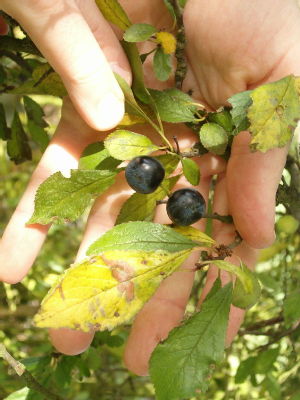


October 23, 2004
Albania land of champagne
The people of Albania unite and celebrate the victory of the proletariat! Comrades Peter and Sylvia, taking a well earned break from lion hunting, have visited the mother land, and their prize for their great son-in-laws? T-shirts that show our alegiance to the great land of Albania.
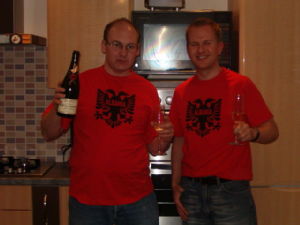
October 17, 2004
Trail Riders Fellowship
Writing about web page http://www.trf.org.uk/

Having just moved to Warwickshire and got my GS Dakar back after a long time not riding (bashed over the head in Spain), I thought I'd have a look at the OS to see where I can ride close to home. I was quite alarmed by the fact that there are no byways around here at all. In Oxfordshire they are everywhere, with many of them radiating out from The Ridgeway.
To find out more, I went to the Behind Bars trail bike shop in Kenilworth. They have a great selection of second hand bikes, including a really nice KTM 640. Their range of high quality professional equipment suggests that they are serious. The young man behind the sales desk (son of the owner), confirmed that there are no byways, but that there are many legal green lanes. He gave me a membership form for the Trail Riders Fellowship, who are the national and local authority on this matter. I've been planning to join for a long time, but in Oxfordshire never found it to be absolutely necessary.
October 14, 2004
University Sculpture Trail
Writing about web page http://vgallery.warwick.ac.uk/gallery/ExhibitionPaged.do?path=h_1/g_101/e_c_12&controlLock=0&datapanelLock=0
Last night Emma and I joined the Warwick Staff Walking Group on a short walk around the sculpture trail. This was organised by Jan Scrine , who also organised drinks and snacks afterwards. The tour was led by the curator of the Mead Gallery and the University Art Collection , Sarah Shalgosky.
As we had only a short period of time before it would be too dark, we could only do half of the trail, but it was still fascinating. The guided version of the trail is designed for school parties, although in this case it was adapted perfectly for the walking group. For each sculpture, Sarah asked interesting questions about how it was created and why it is as it is. Emma is head of KS1 at a local primary school, and leads the use of art as a means of teaching, so was very interested in this.
The sculptures that we looked at were:
- 3B Series 1 by Bernard Schotlander – the assemblage of red shapes opposite Rootes Residence;
- Let's Not Be Stupid by Richard Deacon – the giant steel and aluminium sculpture between Rootes and the Arts Centre. Sarah got us to move around this, focusing on how it uses 'negative space' to frame the University, and how it relates 3-d forms to 2-d drawings;
- Dark At Heart by Peter Randall-Page – this presents a sense of something very ancient, fossilised even, protectively wrapped in itself;
- The Higham Bight series of carvings by Keir Smith – of personal interest to Emma as she is from the area of Kent that they are about;
- Op Mobile No. 10 by Nechemia Azaz – the beautiful soaring eagle in the Arts Centre;
- White Koan by Lilian Lijn – a fascinating woman and a really special part of the University.
These are just part of the collection of artworks on campus, there are over 800 of them displayed around the University. You can see more of them online at the University of Warwick Art Collection web site. If you get a chance to do the Sculpture Trail, do so, it's great.
Once it got dark, we returned to the Mead Gallery, which houses temporary exhibitions by contemporary artists. Sarah gave an informative talk about the Mead, and about the current exhibitions. I'm particularly impressed with New Life by David Burrows, which is currently showing (more blogging on that soon). The Mead is free and open until 9pm. You can get more information on the Mead's website .
October 03, 2004
Chasing Che book review
Follow-up to The Motorcycle Diaries – book and movie review from Transversality - Robert O'Toole
- Title:
- Rating:

This book makes a great companion to Ernesto Guevara's Motorcycle Diaries, and the current movie adapted from it. In fact I suspect that Patrick Symmes book was used to research the film, as I noticed several details in the movie from the book.
Chasing Che is a great work of research, investigating the journey made by Ernesto (Che) and Alberto. Symmes travelled along the same route, this time using a bike built for the journey (a BMW R80 G/S, which is a slightly older and smaller version of the R100 GS-PD that I ride). Not only does this journey help to make Ernesto's book more realistic, but also more concrete, as many of the places visited in the original journey are rediscovered. And of course the comparison between the Latin America of Ernesto's youth and that of today is of great significance.
Another great book by a GS rider, even if he does constantly describe his bike as "the ugly cockroach".
The Motorcycle Diaries – book and movie review
- Title:
- Rating:

On the 4th of January 1952, two medical students left Buenos Aires together on an old British motorcycle, for an adventure that was double in every way. This book is the diary kept by Ernesto Guevara de la Serna on his travels through America with his friend Alberto Granado, together riding La Poderosa II, "the Mighty One".
This isn't a tale of derring-do, nor is it merely some kind of 'cynical account'; it isn't meant to be, at least. It's a chunk of two lives running parallel for a while, with common aspirations and similar dreams. In nine months a man can think a lot of thoughts, from the height of philosophical conjecture to the most abject longing for a bowl of soup – in perfect harmony with the state of his stomach. And if, at the same tme, he's a bit of an adventurer, he could have experiences which might interest other people and his random account would read something like this diary.
The nine months is of course symbolic. The adventure was both an escape and a birth, a romance and conception followed by a painful awakening to the world. It is double in every way.
Ernesto feels the pain of having to leave his beautiful girlfriend, romance succumbing to the companionship of his comic and earthy friend Alberto. The two of them and La Poderosa cross the vast expanse of the Pampas, the freezing inhospitability of the Andes, the dry world of the Atacama, and into the Amazon. With little money, they are reduced to scamming food and beds in often hilarious ways.
But this journey is an encounter with tragedy as much as with comedy. The tragedy of the peoples of America is their all along. Peasants disposesed, miners abused, a leper colony subject to the prejudices of the Catholic Church. And through all this we see Ernesto, the natural born doctor, not only helping the sick, but also slowly becoming aware of what he might do to help his fellow Latin Americans. A learning through practical encounters of the sort also documented by Ted Simon and other long-distance motorcyclists.
And by the end of the journey, these parallel lives, so different as they are, become deeply connected. Alberto and Ernesto finally refer to each other as 'Che', a special kind of Latin American friendship. Che Guevara is born.
This is a great book, although necessarily fragmented. It is now accompanied by a book by Alberto, who is still alive, and much historical research. You are probably aware that it has also been made into a movie, currently showing at the Arts Centre. The movie is magnificent. Brilliantly adapted, acted, and filmed. The double nature of the book is perfectly represented, and the words of Che echo throughout the beautiful, comic and tragic scenes.



 Please wait - comments are loading
Please wait - comments are loading